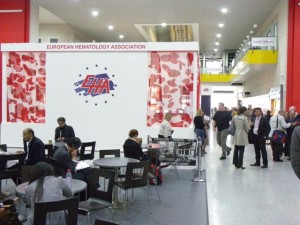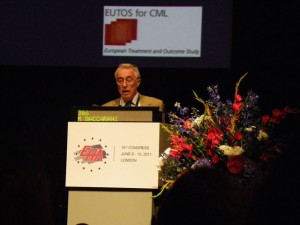Webcasts of EHA Education Sessions are well worth watching
 At the 16th Congress of the European Hematology Association (EHA) that was held in London this past weekend, the educational sessions were extremely well attended.
At the 16th Congress of the European Hematology Association (EHA) that was held in London this past weekend, the educational sessions were extremely well attended.
The reason for this was the quality of the thought leaders who presented on science and emerging treatments.
The quality of the education sessions and the fact they are repeated twice, so you can avoid schedule clashes, is one of the things I particularly like about both the American Society of Hematology (ASH) and European Hematology Association (EHA) annual meetings.
As I have written before while at EAU in Vienna, I’m not a fan of promotional satellite symposia. As an example on the Thursday before EHA, attendees interested in CML could attend the Novartis symposia in the morning about how nilotinib was better than imatinib, then in the afternoon attend the BMS sponsored symposia to hear how dasatinib was also better than imatinib. Indeed, two of the speakers were identical in both symposia, but with entirely different messages.
Two other satellite symposia also had speakers talking about second-generation tyrosine kinase inhibitors. What, of course, was on everyone’s mind was when to use one second-generation TKI over the other? Also given that imatinib is reimbursed in many countries, while nilotinib and dasatinib are often not yet available in that setting, the issue of how to treat patients second-line with these therapies was also a hot topic.
However, just attending the individual company-sponsored symposia, to me, meant that it was hard to put together a big picture of exactly what to do when. Perhaps a better way to handle it would have been to have one CML satellite symposia sponsored by all the companies with a dog in the race (Novartis, BMS, Ariad, Pfizer). We might have heard what the experts really thought that way. 🙂
The other issue that arose during the meeting is how data is presented when looking strategically at one treatment or trial to another in the same indication. Are you truly comparing apples with oranges?
 As Professor Michele Baccarani pointed out, there is a big difference between data that shows a cytogenetic or molecular response “BY” a certain time as compared to “AT” a certain time.
As Professor Michele Baccarani pointed out, there is a big difference between data that shows a cytogenetic or molecular response “BY” a certain time as compared to “AT” a certain time.
“BY” can include patients who had a response then went in remission, so could present a higher number than “AT” data that shows only those patients who have a response at that cut-off date. This is an important distinction, for example, when comparing data from the BMS DASISION trial and Novartis ENESTnd trials to long-term survival data for imatinib versus interferon-alpha from the IRIS trial.
So, it was left to the EHA education symposia to provide some practical guidance. In an excellent presentation, Hagop Kantarjian M.D. from MD Anderson provocatively presented his CML treatment guidelines, and discussed when you would use one drug over the other along with the importance of routine monitoring to evaluate how well a patient was doing on therapy.
Webcasts from the EHA education sessions will be available online soon and are well worth watching if you were unable to be in London this past weekend.